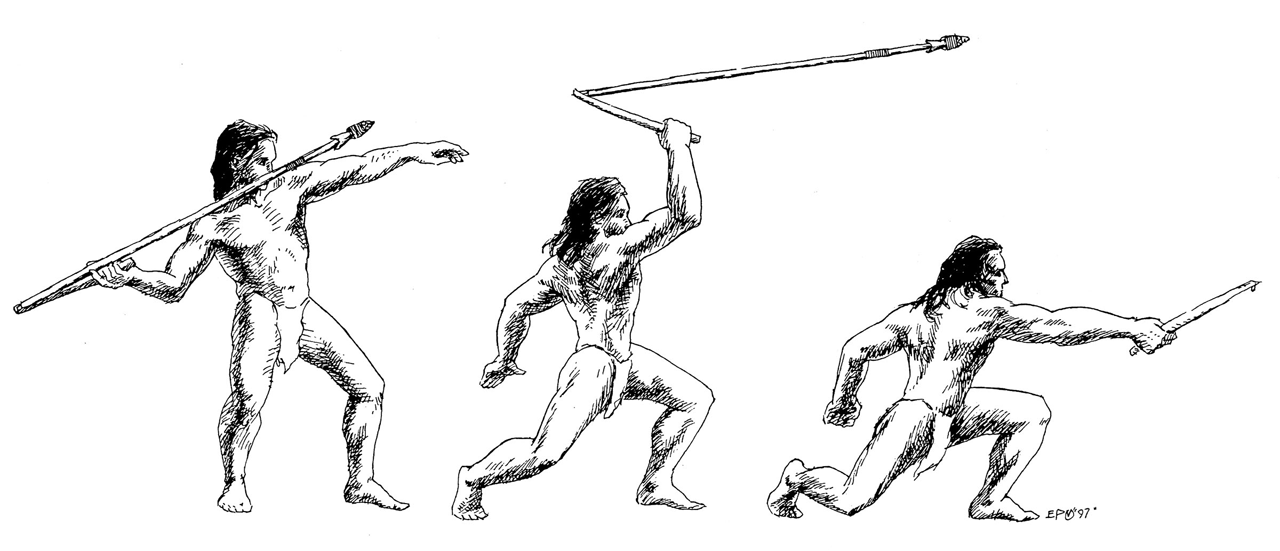
Drawing by Eric Parrish. Copyright © E. James Dixon; used by permission. From Bones, Boats, and Bison, Figure 6.1.

Drawing by Eric Parrish. Copyright © E. James Dixon; used by
permission. From
Bones, Boats, and Bison, Figure 6.1.
Hand-thrown spears have limited speed, range, and accuracy. Sometime before
17,000 years ago, humans invented a launching tool that greatly improved the
effectiveness of spears. The launching tools are known by their Aztec name,
"atlatl." Eric Parrish's
drawing shows how an atlatl works to extend a thrower's arm.
Eventually a new invention, the bow and arrow, replaced atlatls, but not
completely. The Spanish who conquered Mexico encountered atlatl-using
warriors. Arctic hunters continued to use spears launched with "throwing
boards" well into the 1900s. A few Australians reportely still use
their version of the atlatl—the woomera—to hunt.
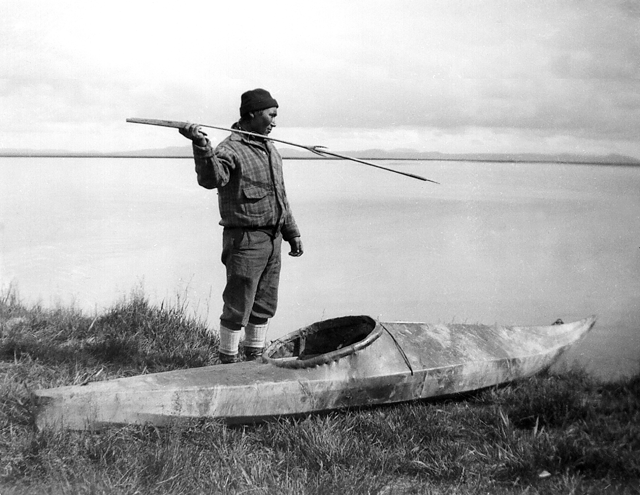
Man with bird spear and throwing board, Kivalina, Alaska, 1932.
Dr. Julien G. Manser Collection, 69.71.234
The hunter in the image shown above was able to hit a 3 by 5 inch (8 by 13 centimeter) piece of paper from a distance of 25 feet (7.6 meters), two times out of three.
Minimally, an atlatl consists of a shaft (usually wood) with a hook at
one end. The hook fits into a socket (shallow cavity) at one end of the
spear, and keeps the spear from slipping off the atlatl as a hunter
launches the spear. A common improvement is leather finger loops, which
helps the thrower maintain a firm grip on the atlatl. The next photo shows
a modern replica of an atlatl, with a piece of antler for the hook.

Basketmaker style replica atlatl made by Jeremy Decker.
Photograph by, copyright © Jeremy Decker; used by permission.
Similar atlatls were used throughout the U.S. Southwest. The next photo shows an archaeological example from southern New Mexico. Worn places on the handle end show where the finger loops were attached. The loops were probably made of animal hide or braided plant fiber yarn.
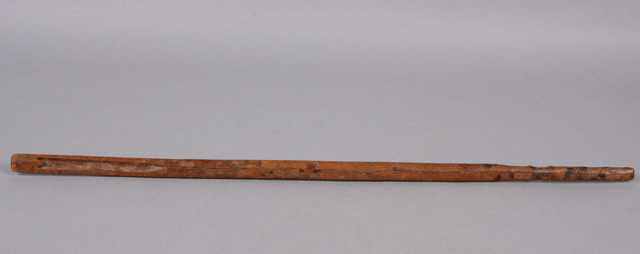
64.69.1, atlatl; carved wood, 57 centimeters (22 1/2 inches) long
Mogollon culture; Luna County, New Mexico
Donated by Russell Schorsch;
Photograph by B. Bernard
Instead of an antler hook, this one has a hook carved directly into the wood. The hook was used to hold the base of a spear in place until the thrower let go.
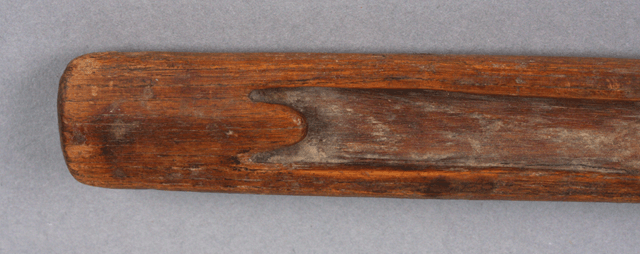
Close-up of the carved hook.
Photograph by B. Bernard
The spears launched by atlatls are most often referred to as "darts." Examples from the prehistoric U.S. Southwest typically have a main shaft and a foreshaft. The main shaft was made from a light, straight piece of wood (such as a sapling or a piece of cane). The foreshaft was made of hardwood, so it could resist shattering and absorb some of the shock that would otherwise shatter the light but delicate main shaft. The usual dart tip was a point flaked from stone.
The next two photographs show a couple of foreshafts notched at the "business"
end to receive a stone point. The first photo shows the entire length of the
foreshaft. The second provides a closeup of the notches and points. Both
points have lost their tips, probably as the dart struck its target (or
missed the target and struck the ground). When points did lose their
tips, the composite construction of the dart (main shaft versus foreshaft)
allowed hunters to switch out points in the field. More extensive repairs
(re-pointing the piece of stone, or replacing the stone point entirely)
could be done back at camp.
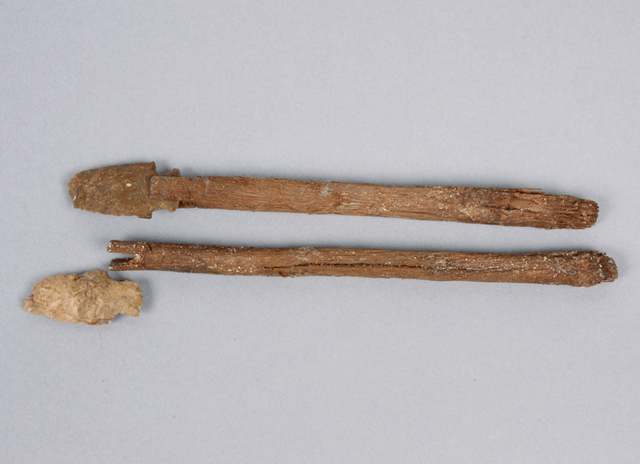

Two atlatl points of stone; two wood foreshafts
Archaic period, San Jose phase (3000–1800 B.C.)
Correo, New Mexico
UNM field school collection
Photograph by B. Bernard
Of course, the stone point had to be secured to the foreshaft. Sinew
was ideal for this purpose, and the ancient sinew wrapping has survived
in the example shown below. The corner notches seen on many stone points
helped the sinew secure the point to the foreshaft.

Atlatl foreshaft with point; wood, stone sinew
Archaic period, San Jose phase (3000–1800 B.C.)
Correo, New Mexico
UNM field school collection
Photograph by B. Bernard
Stone points were not always used, however. Instead, hunters sometimes
inserted rounded wood tips, or bunts, in the front of their darts.
Three examples are shown below, and explained after the photograph.
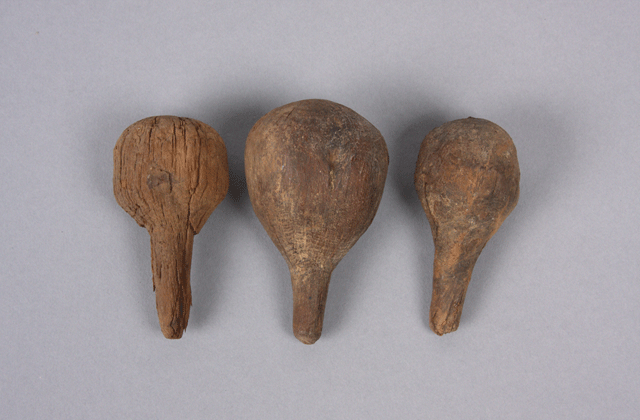
Atlatl bunts; wood
Archaic period? (pre-A.D. 500)
Correo, New Mexico
UNM field school collection
Photograph by B. Bernard
Why a rounded wood bunt instead of a sharp stone point? If you were hunting
small game, such as rabbits or birds, an atlatl dart with a sharp tip would
tear up your game (and, among other things, promote rapid spoilage). A blunt
tip could be used to stun game instead. Or, if the animal was killed, it
would not be torn by the dart.
To return to the "atlatls" thumbnail on the Tools page, please click here.
All original content copyright © Maxwell Museum of Anthropology, University of New Mexico. High-resolution versions of Maxwell Museum photographs may be ordered from the Maxwell Museum's photo archives. Please make note of the catalogue numbers. For more information please visit the photo archives web page
Page last revised on April 21, 2014. Please report problems to toh@unm.edu